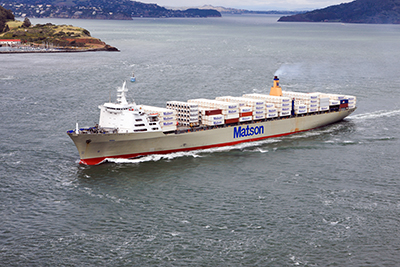Matson continues to post good ocean and logistics numbers
Matson achieved better than expected second quarter results, buoyed by stronger demand for our expedited China service, the timing of fuel surcharge collections, higher lift volumes at its SSAT terminal joint venture, and improved performance in logistics

In marked contrast to most of the players in today’s ocean cargo marketplace, Oakland-based Matson, Inc., a leading U.S.-flagged transpacific carrier, recently reported strong bi-annual earnings.
For the six months ended June 30, 2017, Matson reported net income of $31.0 million, or $0.72 per diluted share compared with $36.1 million, or $0.83per diluted share in 2016. Consolidated revenue for the six month period ended June 30, 2017 was $986.9 million, compared with $921.9 million in 2016.
"Matson achieved better than expected second quarter results, buoyed by stronger demand for our expedited China service, the timing of fuel surcharge collections, higher lift volumes at our SSAT terminal joint venture, and improved performance in Logistics,” said Matt Cox, Matson's Chairman and Chief Executive Officer
However, these gains were moderated by lower construction related cargo to Hawaii as the boom of high-rise condominium developments in Honolulu has begun to ebb and other real estate construction activity has yet to offset that decline.
"For the balance of 2017, we continue to expect modest improvement in each of our core trade lanes with the exception of Guam where we expect further competitive losses due to the launch of a competitor's weekly service in December 2016,” said Cox.
Walter Kemmsies, Managing Director, Economist and Chief Strategist of JLL’s Port, Airport and Global Infrastructure (PAGI) group, told LM in an interview that Hawaii is challenged by the fact that there’s little room to build distribution centers near its ports.
“And coupled with pressure to move cargo from the first to last mile, this presents challenges for the future,” he said.
Hawaii’s economy experienced modest growth in the second quarter 2017; however, Matson’s container volume was lower due to the absence of volume gains associated with a competitor's service reconfiguration and related issues in the second quarter of 2016, and lower construction related volumes. Given the timing of the expected transition of construction activity and the absence of a 53rd week in 2017, Matson expects its full year 2017 Hawaii container volume to be modestly lower than the level achieved in 2016.
In China, Matson’s container volume in the second quarter 2017 was 15.0 percent higher year-over-year due to stronger demand for Matson's expedited service and an additional sailing. The company continued to realize a sizeable rate premium in the second quarter 2017 and achieved average freight rates modestly higher than the second quarter 2016. For the remainder of 2017, Matson expects continued strong demand for our highly differentiated expedited service amid a chronically over-supplied international container shipping market.
In Guam, as expected, Matson’s container volume in the second quarter 2017 was lower on a year-over-year basis, the result of competitive losses to a U.S. flagged containership service that increased its service frequency to weekly in December 2016. For the balance of 2017, Matson expects a continued heightened competitive environment and lower volume.
In Alaska, Matson’s container volume for the second quarter 2017 was 1.1 percent lower year-over-year, primarily the result of the continued energy sector related economic contraction, partially offset by improved seafood harvest. For the remainder of 2017, Matson continues to expect modestly lower volume based on declining northbound freight due to ongoing contraction of Alaska's energy-based economy, partially offset by improved southbound seafood volume.
As a result, Matson expects Ocean Transportation operating income for the full year 2017 to be lower than the $141.3 million achieved in 2016. In the third quarter 2017, Matson expects Ocean Transportation operating income to be moderately higher than the $42.7 million achieved in the third quarter 2016.
For its logistics operations, the outlook is quite positive.
In the second quarter 2017, operating income for the logistics segment included a full quarter of freight forwarding operating results from its acquired Span Alaska business. For the full year 2017, the company expects Logistics operating income to be approximately $20 million, up significantly from the 2016 level of $11.9 million, primarily due to the inclusion of Span Alaska's freight forwarding business for a full year. In the third quarter 2017, the Company expects Logistics operating income to be approximately double the $3.5 million achieved in the third quarter 2016

Article Topics
News & Resources
Latest in Materials Handling
Automate & Accelerate: Replacing Pick-to-Light with the Next Generation of Automation 6 Ways to Re-evalute Fulfillment This Year MHEFI awards record-breaking $231,700 in scholarships to 61 students ALAN opens nominations for 2024 Humanitarian Logistics Awards Kenco to install an AutoStore system at its Jeffersonville, Ind., DC Schneider Electric rolling out WMS and TMS solutions from Manhattan Associates at scale Leaders Q & A with Bryan Ferguson: Resurgence of RFID technology More Materials HandlingAbout the Author
Subscribe to Materials Handling Magazine

Find out what the world's most innovative companies are doing to improve productivity in their plants and distribution centers.
Start your FREE subscription today.
May 2024 Modern Materials Handling

Latest Resources










